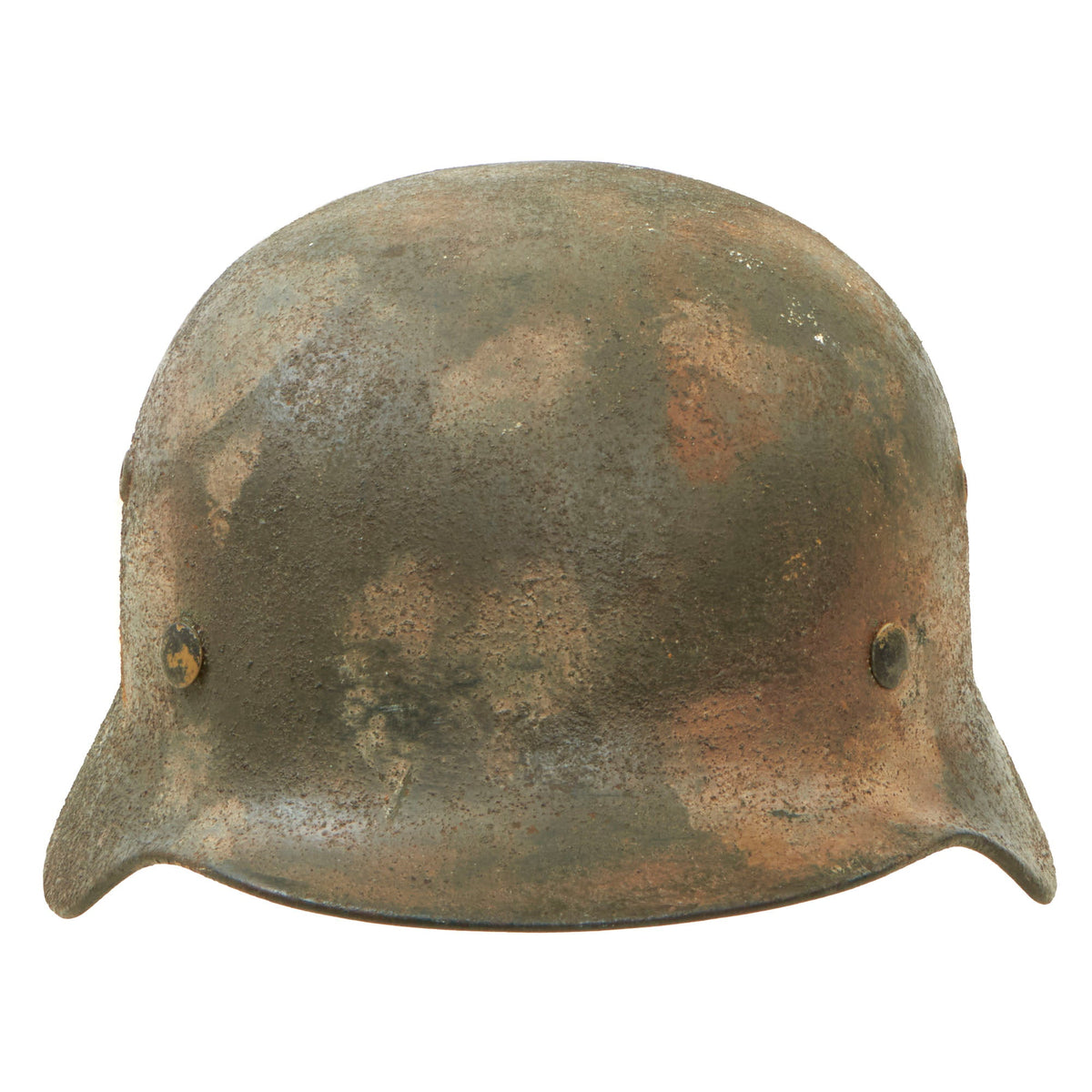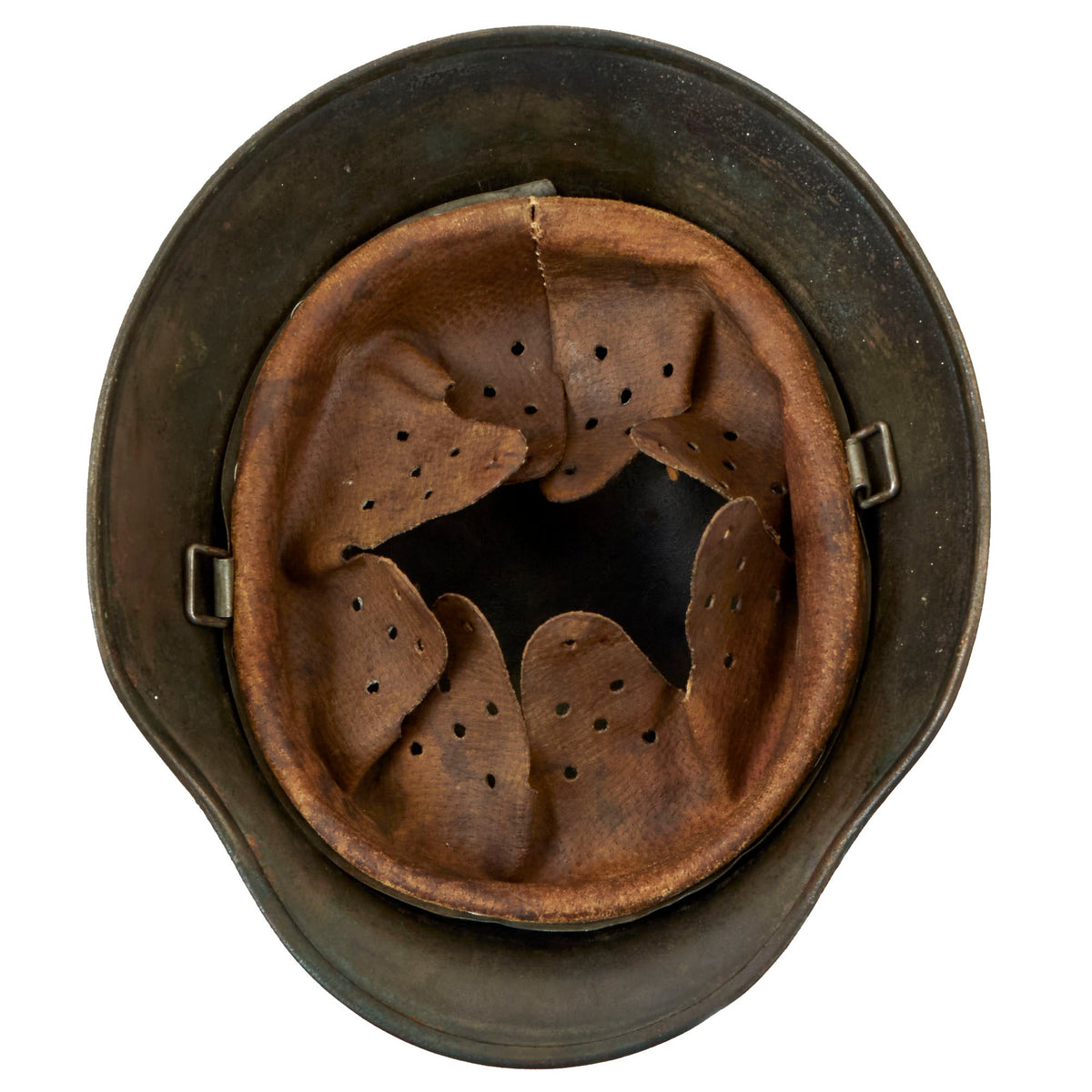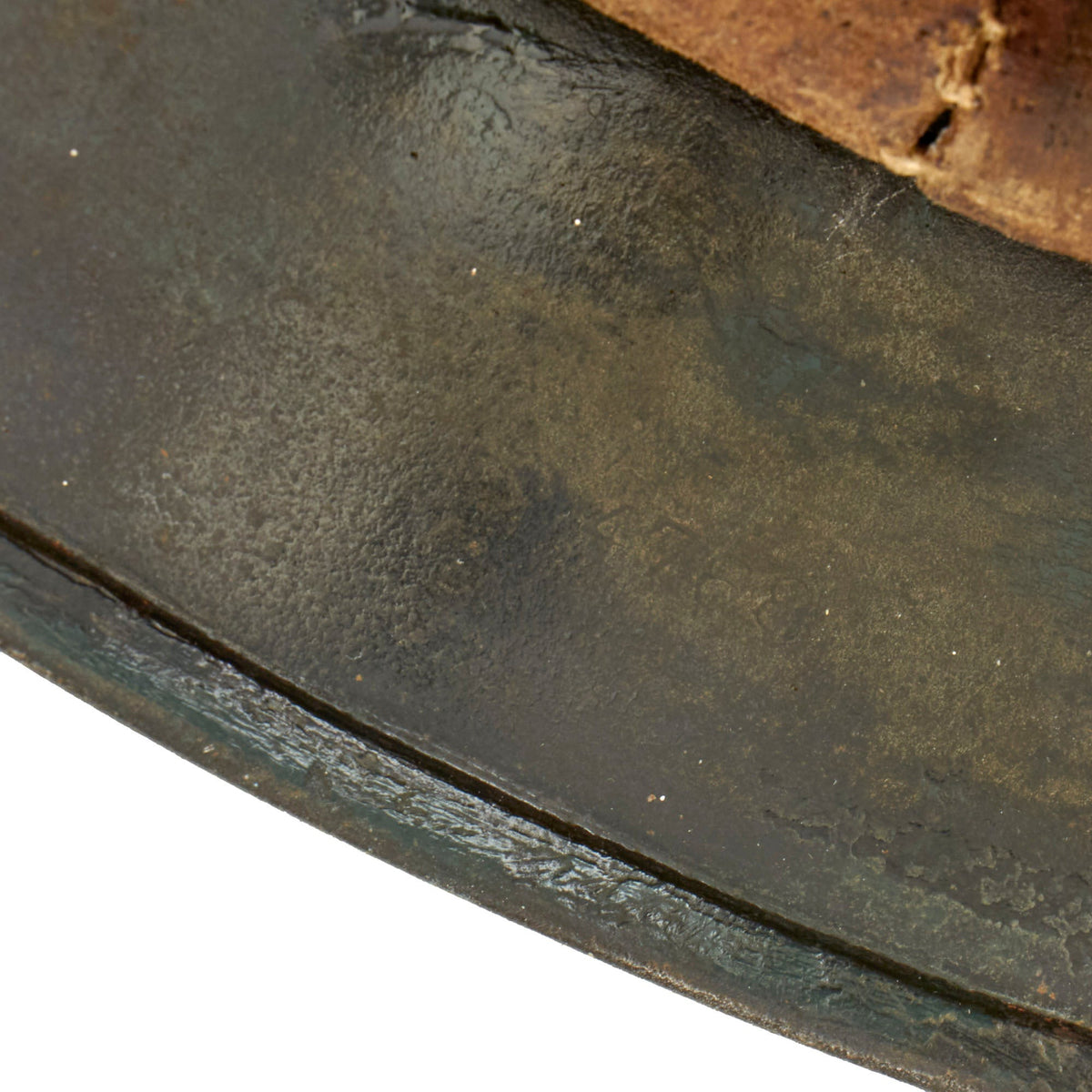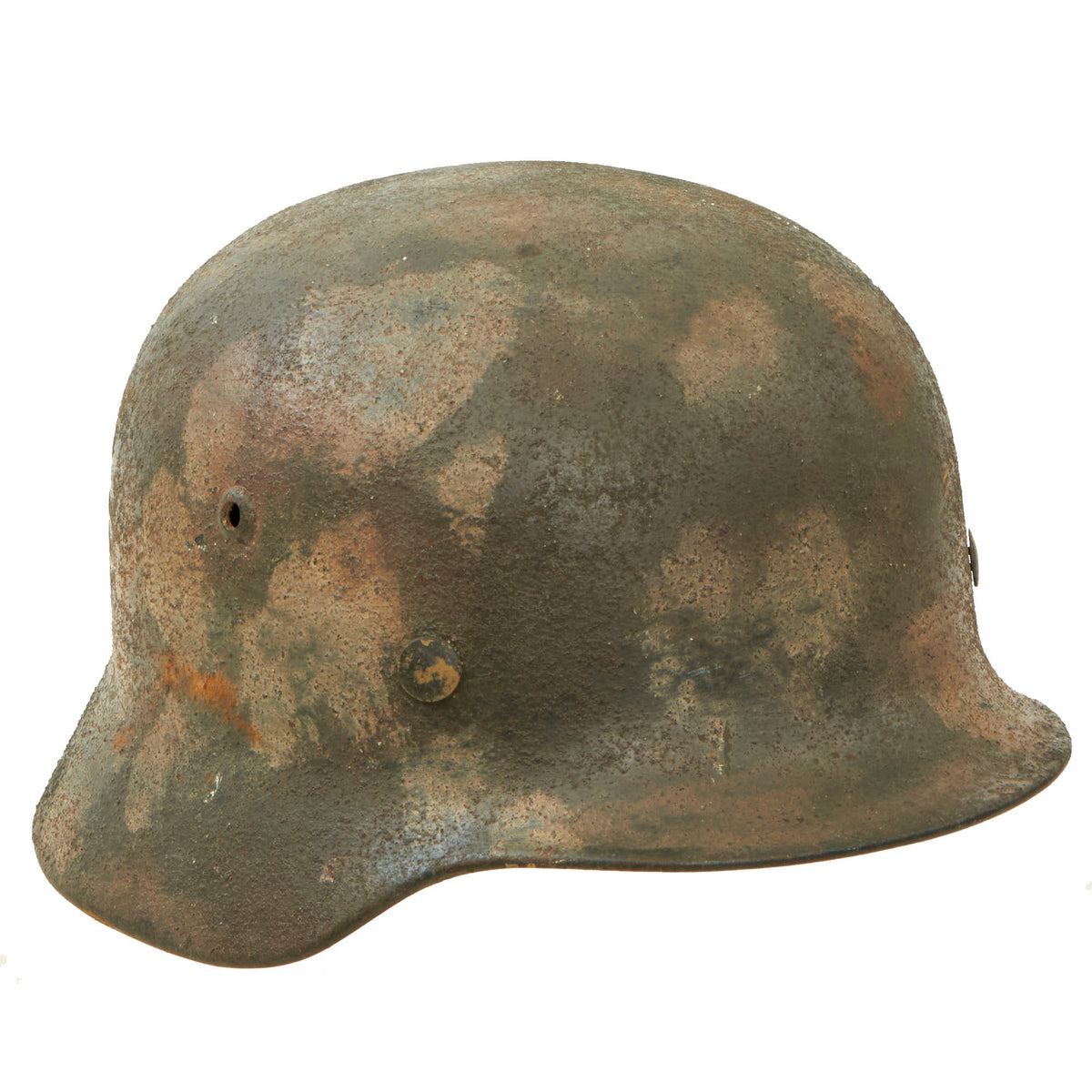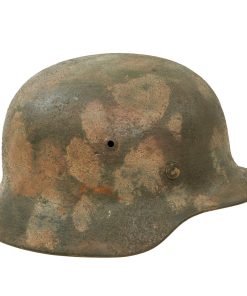Original German WWII Army Heer M35 Textured Camouflage Helmet with Possible Replaced Liner – Stamped Q62 Original Items
$ 895,00 $ 223,75
Original Item: Only One Available. This is a very nice all original example of a German WWII M35 helmet, issued to the Heer (Army) during the early war period. This stamped sheet steel construction helmet looks to have been in service for some time, and has a lovely period applied textured camouflage paint job on the exterior. It is definitely an interesting pattern suggesting service in possibly the Italian campaign or the Southern portion of the Eastern Front., The interior still shows some of the original Apfel-grün (apple green) paint in areas, but also itself shows a lot of wear. The liner is a German example, but it may have been replaced late in the war or possibly post war.
Most of the camouflage is still retained, showing wear through around the bottom edge, and also in various places on the top. There is some light oxidation in places as well where the paint has chipped, giving this helmet a fantastic service worn patina that cannot be duplicated!
The reverse, interior, neck guard apron is batch number stamped 4768, and the interior, left side, apron has a stamped manufacturer’s code and size, Q62. This indicates it was manufactured by F.W. Quist G.m.b.H. in the German city of Esslingen, Germany. Size 62 is a nice smaller size that can accommodate liners from 54cm to 55cm or US 6 3/4 to 6 5/8.
All three liner retaining pins are intact, and still have much of the camouflage paint still present. The interior of the helmet still has an original M31 leather liner with 8 fingers, however it looks to be a very late issue “pig skin” type, which uses thicker and less flexible leather than the earlier deer skin types. The side of the galvanized steel liner band is marked 64 n.A. / 56, indicating that this is a size 56 liner for a size 64 shell. and it looks to have been adapted to fit into the smaller shell by having the rivets at the rear removed. The right side displays the full manufacture information, as well as a date:-
B. & C.
LITZMANNSTADT
1943
This liner was made by Biedermann & Czarnikow, a German company who moved operations to Łódź in occupied Poland to take advantage of the slave labor in the ghetto located there. NSDAP authorities renamed Łódź to Litzmannstadt in honor of the German General Karl Litzmann who had captured the city in the previous World War. This is exactly the type of liner we would expect to see in a helmet refitted later during the war, and it possibly had the leather portion replaced. There is no chinstrap installed.
Overall a very nice 100% genuine M35 Heer Army Textured Camouflage helmet, that definitely saw long service during the war. M35 helmets of this quality are always the hard to find on the market. This is an item that will only continue to appreciate in value over time.
The first “modern” steel helmets were introduced by the French army in early 1915 and were shortly followed by the British army later that year. With plans on the drawing board, experimental helmets in the field, (“Gaede” helmet), and some captured French and British helmets the German army began tests for their own steel helmet at the Kummersdorf Proving Grounds in November, and in the field in December 1915. An acceptable pattern was developed and approved and production began at Eisen-und Hüttenwerke, AG Thale/Harz, (Iron and Foundry Works), in the spring of 1916.
These first modern M16 helmets evolved into the M18 helmets by the end of WWI. The M16 and M18 helmets remained in usage through-out the Weimar Reichswehr, (National Defence Force, Circa 1919-1933), era and on into the early years of the Third Reich until the development of the smaller, lighter M35 style helmet in June 1935.
In 1934 tests began on an improved Stahlhelm, whose design was a development of World War I models. The Eisenhüttenwerke company of Thale carried out prototype design and testing, with Dr. Friedrich Schwerd once again taking a hand.
The new helmet was pressed from sheets of molybdenum steel in several stages. The size of the flared visor and skirt was reduced, and the large projecting lugs for the obsolete armor shield were eliminated. The ventilator holes were retained, but were set in smaller hollow rivets mounted to the helmet’s shell. The edges of the shell were rolled over, creating a smooth edge along the helmet. Finally, a completely new leather suspension, or liner, was incorporated that greatly improved the helmet’s safety, adjustability, and comfort for each wearer. These improvements made the new M1935 helmet lighter, more compact, and more comfortable to wear than the previous designs.
The Army’s Supreme Command officially accepted the new helmet on June 25, 1935 and it was intended to replace all other helmets in service.
More than 1 million M1935 helmets were manufactured in the first two years after its introduction, and millions more were produced until 1940 when the basic design and production methods were changed, replacing the multi-piece riveted vent with one stamped directly into the steel. Later, in 1942 the rolled steel rim was removed from the pattern to further expedite production.
Fast Shipping with Professional Packaging
Thanks to our longstanding association with UPS FedEx DHL, and other major international carriers, we are able to provide a range of shipping options. Our warehouse staff is expertly trained and will wrap your products according to our exact and precise specifications. Prior to shipping, your goods will be thoroughly examined and securely secured. We ship to thousands clients each day across multiple countries. This shows how we're dedicated to be the largest retailer on the internet. Warehouses and distribution centres can be located throughout Europe as well as the USA.
Note: Orders with more than one item will be assigned a processing date depending on the item.
Before shipping before shipping, we'll conduct a thorough inspection of the items you have ordered. Today, the majority of orders will be delivered within 48 hours. The delivery time will be between 3-7 days.
Returns
The stock is dynamic and we cannot completely manage it because multiple stakeholders are involved, including our factory and warehouse. So the actual stock may alter at any time. It's possible that you may not receive your order once the order has been made.
Our policy is valid for a period of 30 days. If you don't receive the product within 30 days, we are not able to issue a refund or an exchange.
You can only return an item if it is unused and in the same state as the day you received it. You must have the item in its original packaging.
Related products
Uncategorized
Band of Brothers ORIGINAL GERMAN WWII Le. F.H. 18 10.5cm ARTILLERY PIECE Original Items
Uncategorized
Australian WWII Owen MK1 Machine Carbine SMG Custom Fabricated Replica with Sling Original Items
Uncategorized
Uncategorized
Uncategorized
Uncategorized
Uncategorized
Uncategorized
Uncategorized
Uncategorized
Uncategorized
Uncategorized
Uncategorized
Uncategorized
Uncategorized


